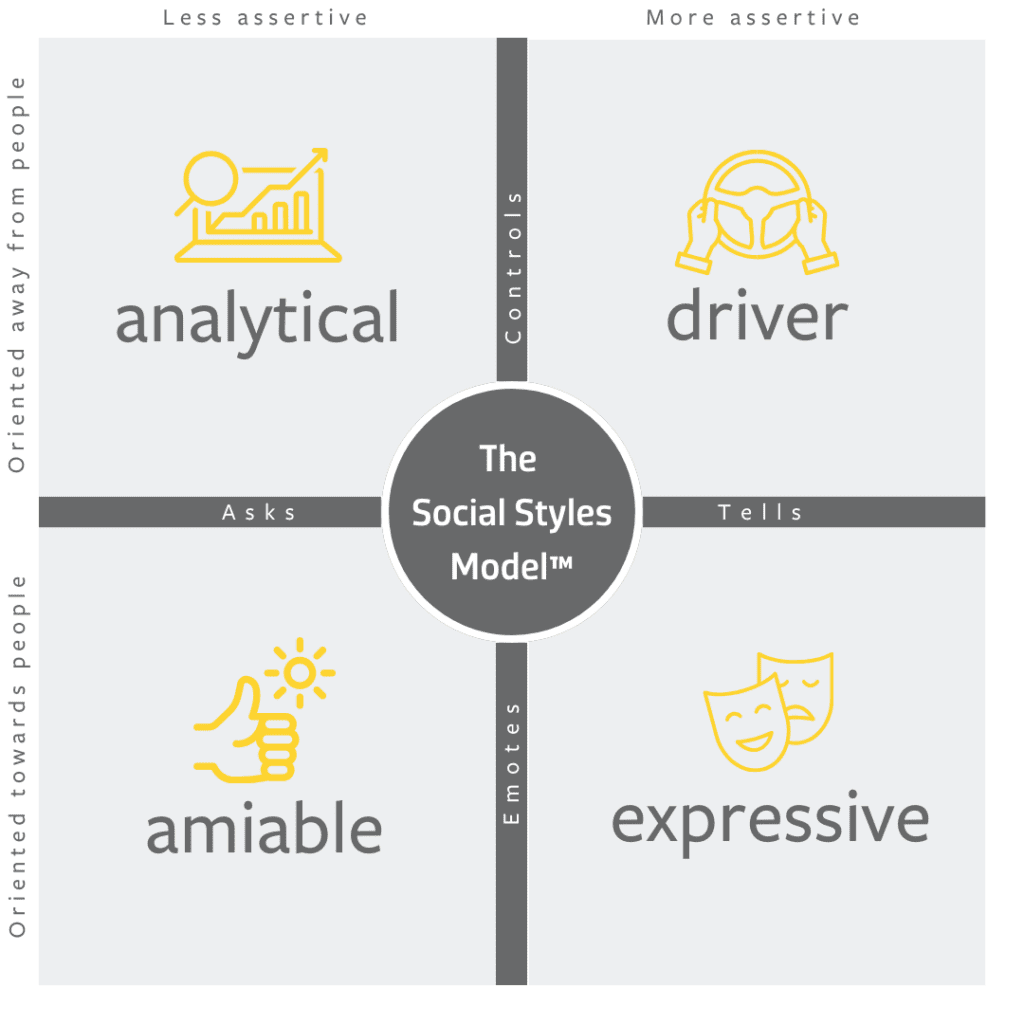
In today’s fast-paced business environment, understanding and predicting behavior is vital to effective leadership. A study by Harvard Business Review, in partnership with the University of Chicago and Copenhagen Business School, found that top-performing CEOs consistently exhibit the ability to meaningfully engage with stakeholders and adapt proactively. These are skills rooted in keen behavioral observation and insight. For executives striving to enhance their leadership, the Social Style Model offers a robust framework. By categorizing human behavior into four distinct styles—Driver, Expressive, Amiable, and Analytical—this model provides actionable insights that drive better communication, collaboration, and overall team performance. Embracing this model can transform how leaders interact with their teams, fostering a more dynamic and responsive organizational culture.
The user-friendly model that produces immediate results
Based on over 60 years of research, the Social Style Model was developed by psychologists David Merrill and Roger Reid in the 1960s. It is designed to focus on observable behaviors rather than personality types, with each style possessing its own distinct and predictable way of interacting with others and making decisions. This distinction makes it easy to identify a person’s social style, including your own, and apply accordingly. Research has shown that it is more accessible and user-friendly than other interpersonal skill training programs, such as DiSC and Myers-Briggs.
The Social Style Model emphasizes versatility, or the ability to adapt one’s behavior to work more effectively with others. Leaders and managers with high social skills and versatility are shown to outperform their peers by 20% or more in the areas of conflict management, team leadership, and ability to achieve results. This adaptability drives better individual performance and executive alignment through improved communication, giving and receiving feedback, and driving motivation. Leaders who understand the different styles of their direct reports “run more effective meetings, can delegate more efficiently, manage conflict effectively, and mentor and develop their people with greater skill,” says Casey Mulqueen, Ph.D, Sr. Director of Learning and Development at Tracom.
Breaking down the four social styles
The Social Styles Model uses two scales: assertiveness and responsiveness. Assertiveness measures how much a person attempts to influence others, divided into “asks” and “tells.” Responsiveness measures how outwardly expressive one tends to be, divided into “controls” and “emotes.” When entered on the x- and y-axis, the four-quadrant model of Social Styles is created.


Analytical
Analyticals are characterized by low assertiveness and low responsiveness, often considered serious, methodical, and reserved. They excel at analyzing situations, which can sometimes make them appear indecisive; however, this is part of their process of gathering sufficient information to make the right decision. Analytical individuals are highly task-oriented, competitive, and driven by a need to win. They seek control and prefer to be in charge, acting quickly and planning carefully. They focus on achieving results and maintaining efficiency. Despite their strengths, they can be impatient and insensitive, particularly when stressed, at which point they may become overly critical and attempt to dominate.
Driver
Drivers exhibit high assertiveness and low responsiveness, often seen as strong-willed and emotionally controlled. They are not risk-averse and may come across as extroverted due to their task-oriented nature and desire for immediate results. Drivers are highly competitive, with a strong need to win and maintain control. They act swiftly, plan meticulously, and make decisive decisions to achieve results. Similar to Analyticals, they are task-focused and have little tolerance for inefficiency and indecision. Under stress, Drivers can become impatient, insensitive, and overly critical, seizing control in an effort to manage situations.
Amiable
Amiables are marked by high responsiveness and low assertiveness, typically seen as easy-going and supportive. They value harmony and cooperation, thriving as team players who seek stability. Relationship-oriented Amiables focus on building strong connections and fostering a collaborative environment. While they share the competitiveness and need for control seen in other types, they prefer to act quickly, plan carefully, and make decisive choices in a manner that prioritizes relationships. Amiables can become impatient and insensitive when stressed, often resorting to controlling behaviors and criticism in an attempt to regain stability and harmony.
Expressive
Expressives are high in both assertiveness and responsiveness, often perceived as outgoing, emotional, and dramatic. They are relationship-oriented, emphasizing the importance of interpersonal connections and creativity. Expressives are competitive and have a strong need to win, seeking control and acting quickly to achieve their goals. They plan carefully and make decisive decisions, focusing on results and efficiency. However, they can be impatient and insensitive, particularly under stress, where they may become overly critical and attempt to dominate situations to assert their control.
Collaborating with different social type
By being present and observing behavior, leaders can attune themselves to their team members’ different social styles, cultivating an engaging environment by moderating their own behavior to suit the individual. The chart below outlines the needs and motivations of each social style with tips on how best to collaborate with each. Meeting people where they’re at builds trust within the team, bolsters innovation, and creates opportunities to maximize team performance.


How social styles can be leveraged for executive performance
We see the Social Styles Model as a valuable framework with which leaders can get to know themselves and those around them. Transcend’s nine competencies of executive performance are grounded in critical behaviors of versatility, such as demonstrating emotional intelligence, driving engagement and authentic communication, and pursuing self-development. Our coaches utilize a variety of behavioral and personality frameworks, including Social Styles, to help clients improve communication, feedback, and collaboration within their teams. Each coaching plan is tailored to the client’s specific needs, with tools and processes that can drive maximum alignment and performance across the organization. For more information on how to use this model as part of our executive performance toolkit, get in touch with one of our coaches today.


